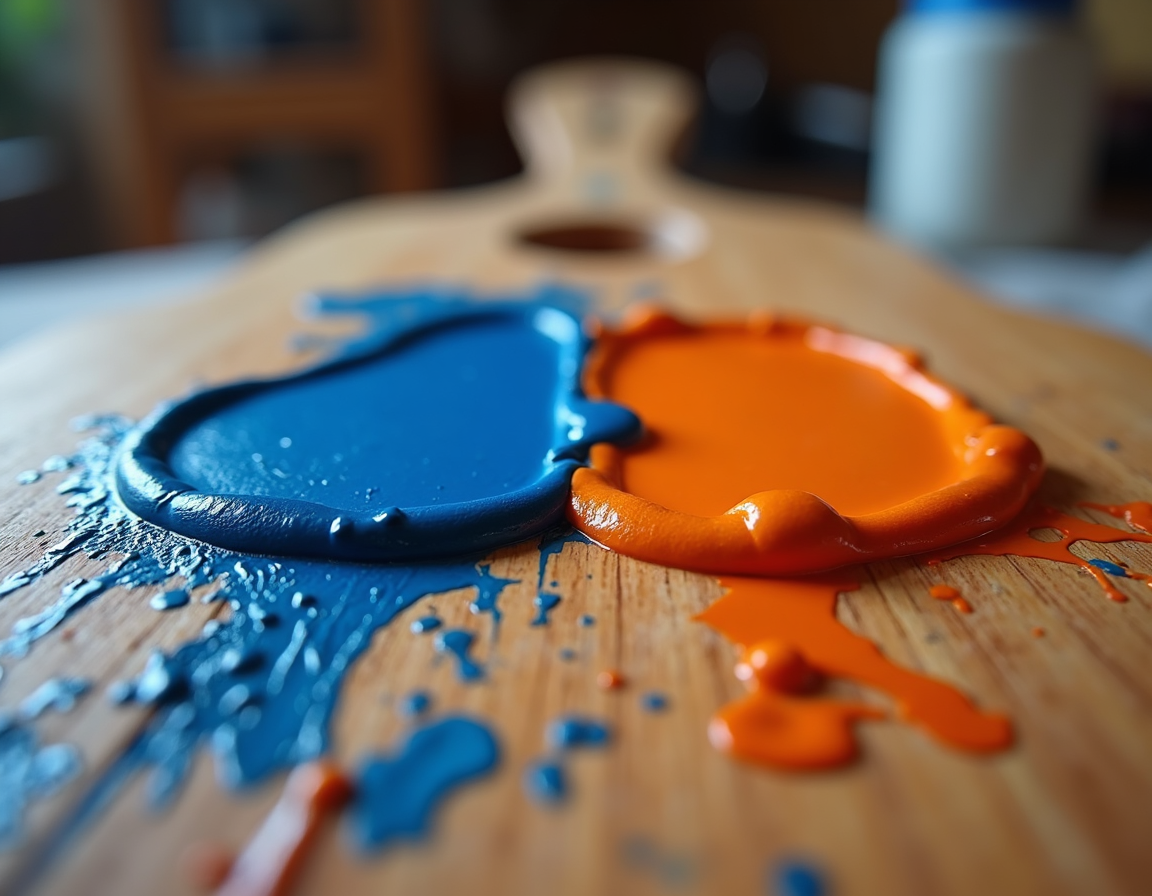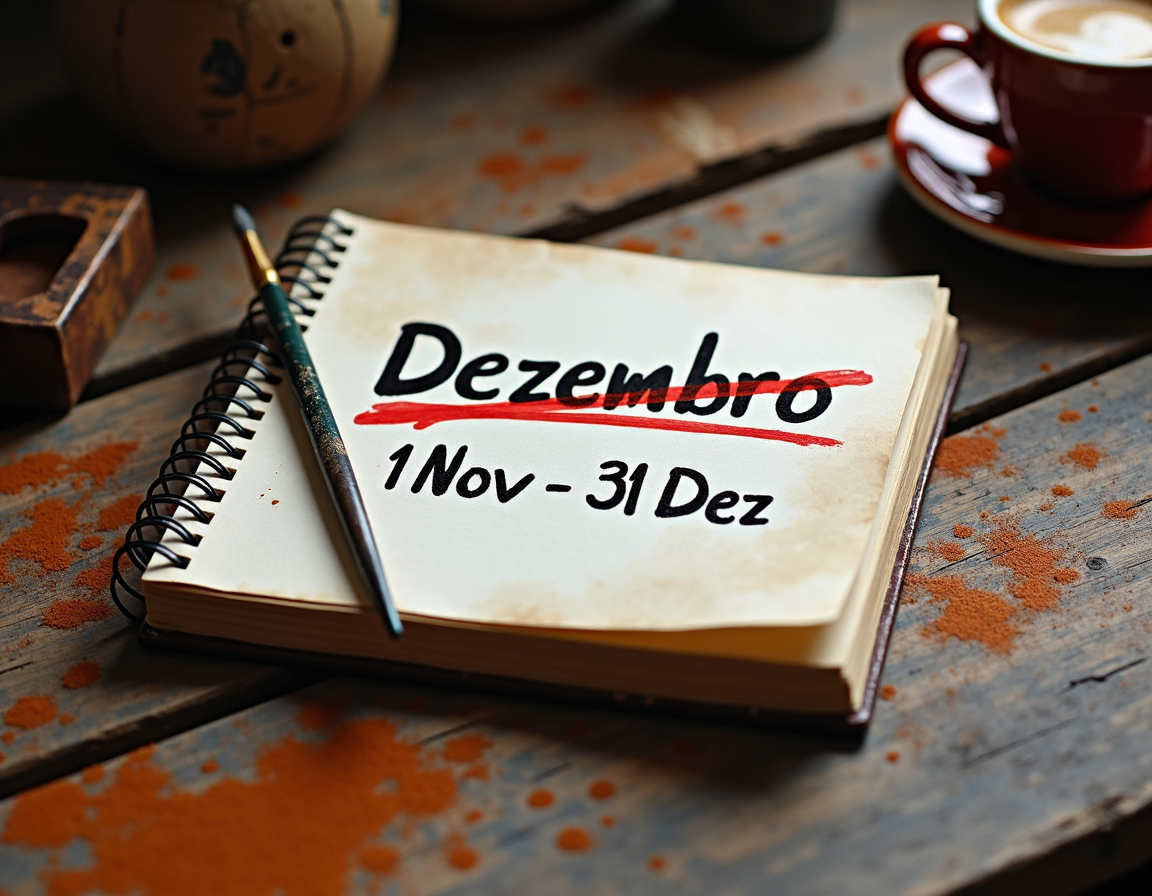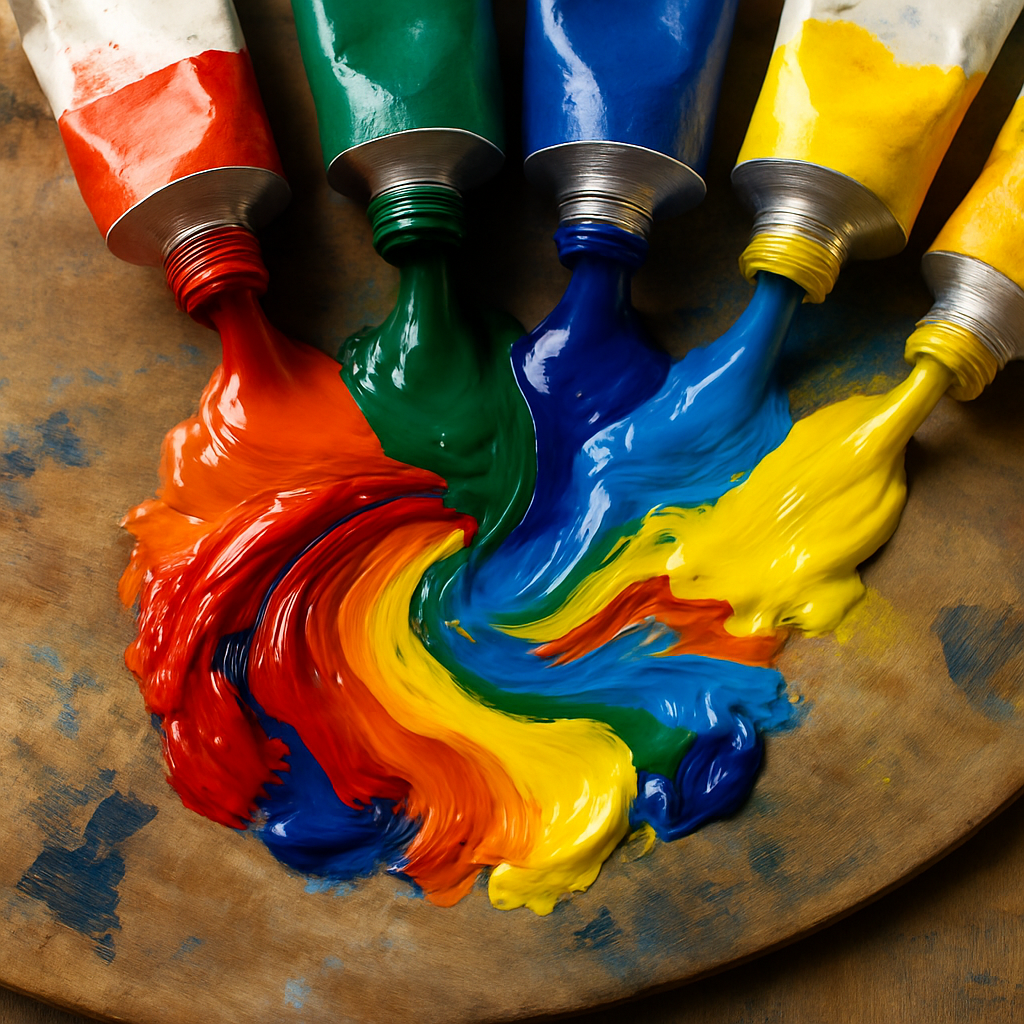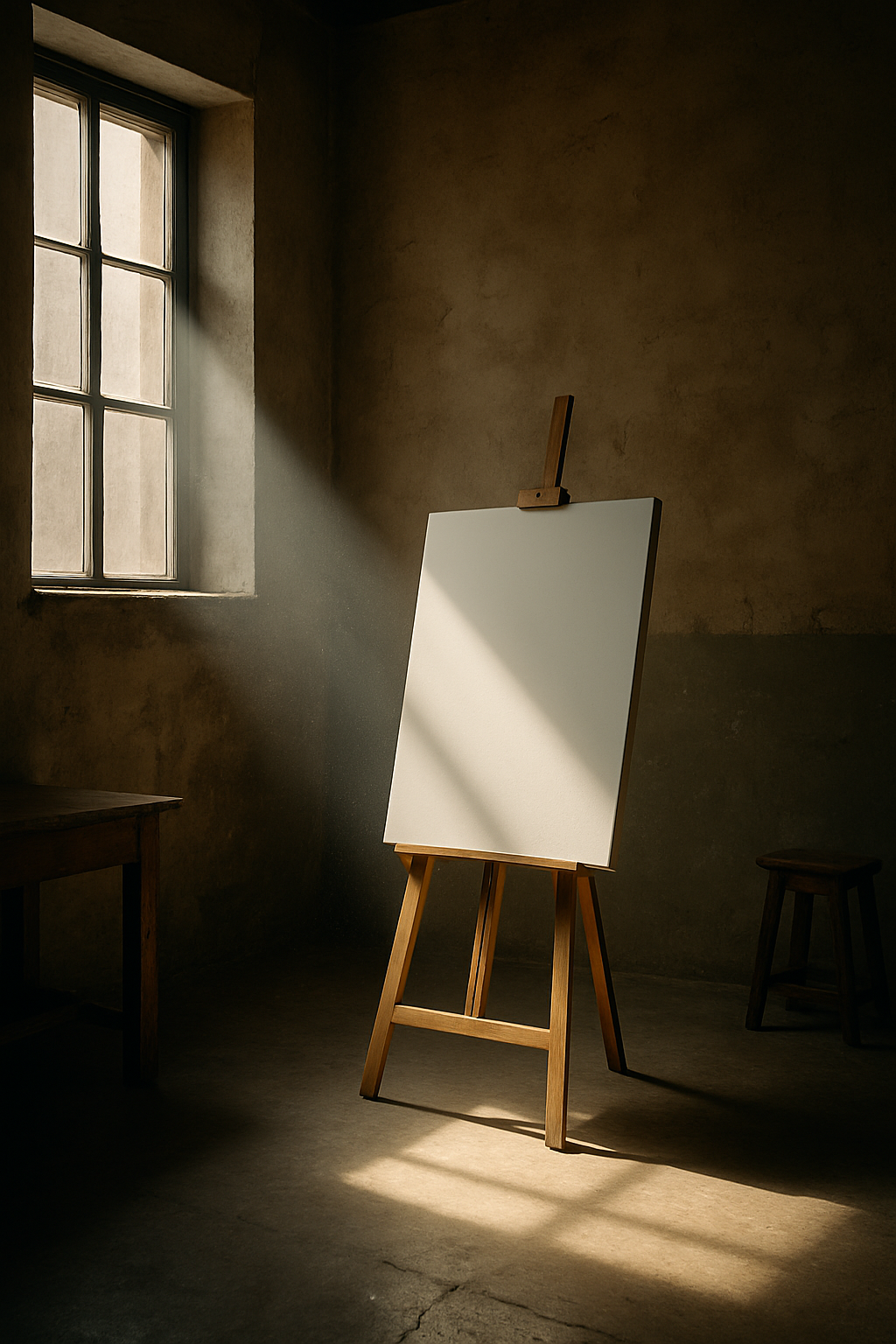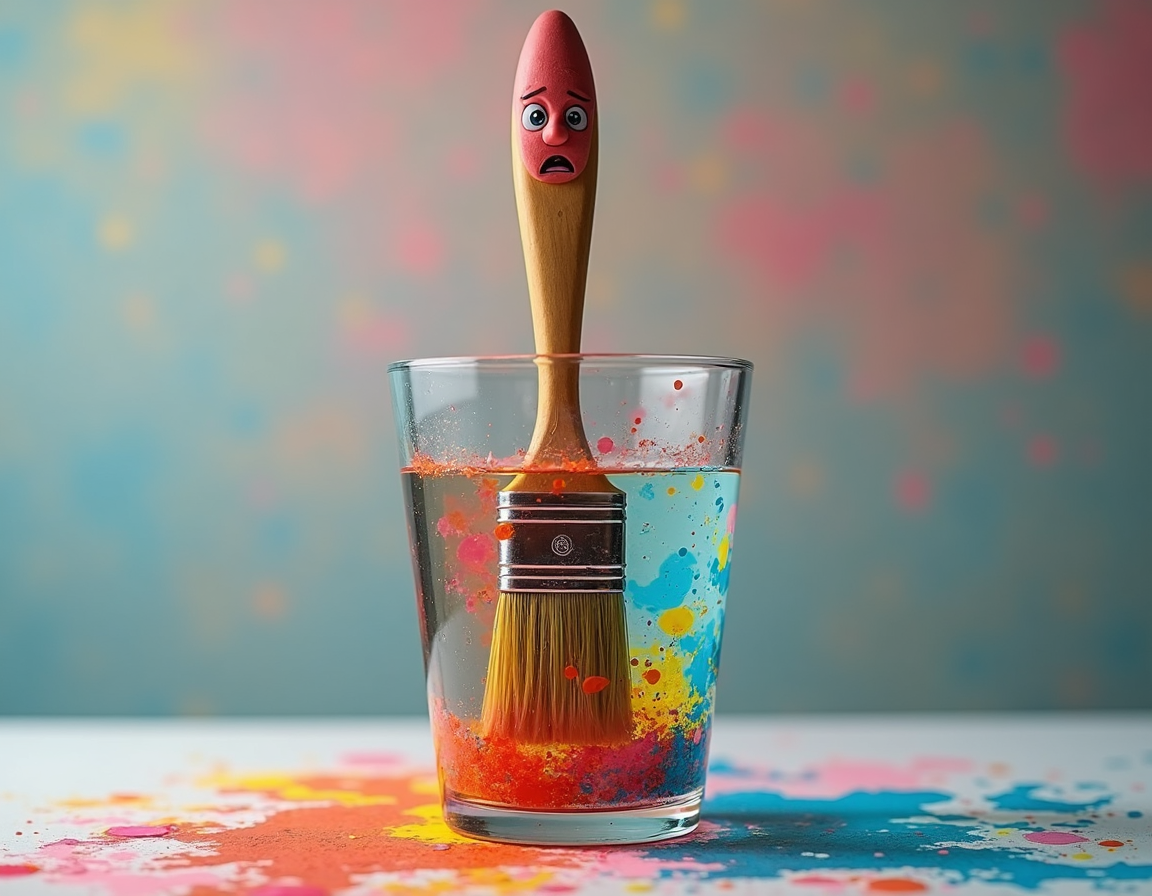Between silence and pigment
A brief return: the studio spoke louder, and silence turned into creation.
After the noise, the studio’s silence remains.
“There are times when silence is the only way to work.” — HMad
It’s been a while since I last wrote here. My bad.
But sometimes the studio speaks louder — and the blog just has to wait for its turn.
The work for the exhibitions ended up multiplying: one in November, another in December.
Two fronts, two tempos, and the same pair of hands trying to keep up.
Between canvases, color, and cold coffee, time simply vanished.
But that’s a good sign — it means the materials took over, and silence turned into creation.
👉 Café conclusion: I wasn’t gone — I was just busy shaping the right kind of noise.
The Colours That Fight With Each Other
Colour theory is one thing. The dramatic relationship between colours on an artist's palette is another, far more entertaining one.
"Colours, like features, follow the changes of the emotions."
— Vincent van Gogh
Colour theory is clear. It talks about complementary colours, harmony, and contrasts that balance each other. All very beautiful.
The artist's heart, however, is a different matter.
There are colours that, on paper, are a dream team. But on the canvas, they're like two cousins at a family party actively avoiding each other. Lemon yellow thinks purple is too dramatic. Green finds red an unbearable show-off.
And then there's the biggest drama of all: blue and orange. Theory says they're complementary, the perfect couple. The reality on the canvas? It's a live couples' argument. One wants to be the serene sky, the other wants to be the explosive sunset. And in the middle is the poor artist trying to play marriage counsellor.
In the end, the canvas is the real therapy room. It's where colours can afford to hate each other, to scream at one another, and where that fight, believe it or not, creates the most beautiful thing of all: life.
👉 Café conclusion: On the canvas, as in life, the best stories always come from the most colourful conflicts.
The Exhibition is Arriving Earlier (And It's Staying Longer)
My next exhibition has been brought forward to November 1st and extended until December 31st. A creative sprint ahead.
"Art, like life, happens at its own rhythm.”— HMad
Well, then. The exhibition that was scheduled for December has decided to take a leap in time.
The gallery called with news. The opening has been brought forward and the duration expanded. The new map is this: the exhibition opens on November 1st and closes on December 31st. Two full months, instead of one.
This completely changes the creative landscape.
And, contrary to what one might think, it hasn't become a marathon. It's become a sprint. A shorter, more intense sprint to have everything ready for November 1st. The adrenaline is different. The pressure too. But the reward is clear: having these two full months, capturing the unique energy of both November and December.
As for what I'm preparing? That conversation is for the coming weeks. The certainty is that the new timeline is injecting a new, urgent energy into the canvases.
Keep checking in here. The news will come as soon as I have it.
👉 Everything else is just café chatter: A sprint now for a long conversation later. The plan is a good one.
5 contemporary artists who reinvented the use of color
Five contemporary artists who turned color into language, experience, and attitude.
Paint tubes in a chromatic revolt.
“Color is the place where our brain and the universe meet.” — Paul Klee
People always bring up Van Gogh, Matisse, and Rothko when talking about color. But what about today’s artists? They’re not living in the shadows — they reinvent color as language, experience, even provocation. Here are five names worth dropping at your next artsy dinner.
Olafur Eliasson
He doesn’t paint, but he paints with light. His installations turn rooms into artificial sunsets and fogs of color. For him, color isn’t pigment: it’s atmosphere.
Anish Kapoor
If you’ve seen that black that swallows your gaze (the infamous Vantablack, and all the drama around it), you know what I mean. Kapoor doesn’t use color as decoration, but as pure power.
Yayoi Kusama
Polka dots, mirrored infinities, and rooms straight out of a pop delirium. Kusama turned color into repetitive obsession — and in that, found freedom.
Sean Scully
Looks like “just” geometry, but it’s poetry in blocks. His stripes breathe, vibrate, almost move. His abstraction is warm, not clinical.
Cecily Brown
She paints like diving into chaos. Colors explode, blur, and collide in furious gestures. Painting that doesn’t ask for permission to enter.
👉 Bottom line, with paint still wet: color has never been just aesthetics — it’s attitude. These five prove it can still be reinvented with every generation.
The creative drama: wood dust and stubborn faces
Between dust, tools, and stubbornness, matter always reminds the artist who’s in charge.
Between dust, tools, and stubbornness.
Sometimes the studio feels like a courtroom: I argue, the wood objects. I imagine fluidity, it insists on throwing back edges.
The result is here — among dust, tools, and a stern face that came out of the block almost out of stubbornness.
👉 The artsy moral of the tale: the artist never beats matter — he just negotiates temporary truces.
Before the first brushstroke
Painting doesn’t start on the canvas, but in the silence that prepares the space for it to happen.
Silence before creation.
“It is not the painter who chooses the painting, it is the painting that chooses the painter.” — Georges Braque
Most people think a painting starts the moment color hits canvas. As if it were instant magic: paint → canvas → artwork.
For me, it starts much earlier. In silence. In emptiness. In that invisible space where the work decides whether it wants to be born.
What comes first
Every series demands its own logic. I’ve seen canvases turn into fragments of memory, into bodies moving, into landscapes to explore. I never repeat the path. Each exhibition forces me to unlearn and invent a new way of thinking.
That’s the risk: walking into a forest I’ve never crossed, with no map, no promise of a way out. And yet — stubbornly hoping there will be light.
Order and chaos at the table
I can sketch plans, fill notebooks with ideas, rehearse in my head. But when the moment comes: color chooses its destiny, gesture takes over, the painting responds. And me? I follow.
It’s in that tense balance between order and chaos that the work reveals itself — and often surprises me more than it surprises you.
The real secret
Maybe the secret is not mastering painting. Maybe it’s just this: preparing the space so that it can happen. Like clearing a path and waiting for the light to break through.
👉 Café conclusion: painting doesn’t begin on canvas, but in the space we open for it to exist. And in December, I’ll be opening that space with you.
Why do we still talk about Van Gogh?
Van Gogh still speaks to us because his painting screams urgency, pain, and beauty — everything art needs.
Vincent van Gogh, “Two Cut Sunflowers” (1887). The Phillips Collection, Washington, Image in public domain by Wikimedia Commons.
“I dream my painting, and then I paint my dream.” — Vincent van Gogh
We talk about Van Gogh as if he were an old friend. And in a way, he is. You know the straw hat, the sunflowers, the ear, the letters to Theo. Even if you’ve never set foot in a museum, you’ve met him.
But why this collective obsession?
Tragedy sells (big time)
Van Gogh is the original rockstar painter: poor, misunderstood, suicidal. He lived in misery, died young, and sold almost nothing in his lifetime. The rest you know — the market and the critics turned him into legend. Culture loves martyrs.
Color that screams
Look at one of his canvases and tell me you don’t hear sound. The yellow of the sunflowers spits light. The starry sky isn’t sky, it’s music in oil. There’s an intensity that cuts across time, almost untranslatable.
The myth of authenticity
In an age of Instagram filters and polished LinkedIn bios, Van Gogh works as a counterpoint. The “mad genius” who didn’t fake it. Who burned from the inside and threw the ashes onto canvas. Truth or romantic construction? Doesn’t matter. It works.
And you?
We still talk about Van Gogh because we need someone to remind us that art isn’t just market, technique, or “good taste.” It’s excess, it’s pain, it’s beauty that disturbs.
👉 Bottom line, with paint still wet: Van Gogh reminds us that for art to be art, it must be urgent.
The most sarcastic quotes about art ever
Five sarcastic quotes about art that cut deeper than most serious critiques.
“Forget art, food comes first.”
Introduction
Nothing like a little artistic sarcasm to kick off the week. Here’s a top list of lines that make you laugh… and sometimes cry.
The gems
“Sculpture is what you bump into when you back up to look at a painting.” — Barnett Newman
“Art is the most expensive excuse for avoiding work.” — Georges Braque
“The only thing I care about in Paris is the food.” — Pablo Picasso
“Criticism is like an electric light: it illuminates, but burns if you touch it.” — Salvador Dalí
“An artist is like a snail: carrying his house on his back and leaving a trail.” — Francis Bacon
Closing
👉 Everything else is just café chatter — but with more irony hanging on the wall.
10 things a paintbrush thinks when left in a glass of water
The secret diary of a paintbrush forgotten in water: 10 tragicomic thoughts you’ll never un-hear again.
“Things have a life of their own. It’s simply a matter of waking up their souls.” — Gabriel García Márquez
You forget the paintbrush in the water. For you it’s nothing. For the brush? Pure tragedy. Between bubbles and fading pigments, it’s living a drama no one ever exhibits.
10 soggy thoughts of a forgotten paintbrush
This isn’t a spa, it’s medieval torture.
If I were wine, you’d have saved me already.
I’m dissolving… goodbye dignity.
Oh look, bubbles! … wait, that’s me dying.
That smug toothbrush is laughing at me.
I’m the one who needs therapy here, not you.
When I dry, you’ll cry for every fine line lost.
Should’ve been a pencil… they never drown.
You call this creative process? Looks more like IKEA punishment.
Next time, leave me on the easel… at least I’ll die standing.
Closing
👉 Bottom line, with paint still wet: never underestimate the drama of a soaked brush.
5 things you should never say to an artist
Five seemingly innocent phrases that can make an artist want to throw the brush out the window.
“An artist is someone who sells what he no longer has.” — Picasso (with his trademark irony)
We all know that friend who thinks they’re being nice… but says the worst possible thing.
To avoid deadly stares and awkward silence, here are 5 gems you should never say to an artist:
“Can you actually make a living from this?”
(Thanks for the concern… now excuse me while I eat my canvas with acrylic sauce.)“But how long did it take you?”
(As if the value was in the stopwatch and not the creation. Spoiler: this isn’t Uber Eats.)“My kid could do that too.”
(Congrats to your kid. Maybe they’re a genius. Or maybe you just don’t get it.)“Can you give me a discount?”
(Sure, and you happily take half your paycheck, right?)“I could do that myself.”
(Then… why didn’t you?)
👉 The no-fluff takeaway
Respect the artist, enjoy the work — and if you can’t think of anything smart to say, just compliment the color.




